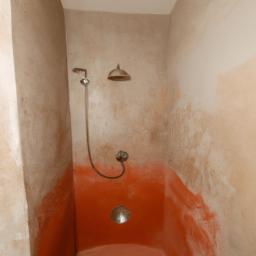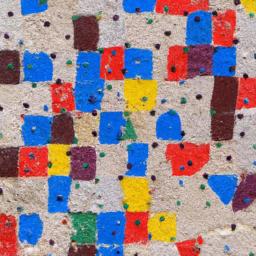Discover the timeless beauty of colored plastering, a form of decoration that adds elegance and sophistication to any interior design. Learn more on Decor Ideas Blog.
If you’re looking for a unique and elegant way to transform your home’s interior, look no further than colored plastering. This decorative technique has been used for centuries, creating a timeless and sophisticated look that can fit any design style. In this article, we’ll explore the history and benefits of colored plastering and how it can elevate your home’s aesthetic.
What is Colored Plastering?

Colored plastering, also known as decorative plastering or polished plastering, is a technique that involves applying layers of tinted plaster onto walls, ceilings, and even floors. The plaster is then polished to create a smooth and shining finish that can mimic the look of marble or other natural materials. This technique originated in ancient Rome and was later popularized in Venice during the Renaissance, where it became known as Venetian plastering.
Importance in Modern Interior Design

In recent years, colored plastering has experienced a resurgence in popularity in modern interior design. This is because of its ability to create a unique and luxurious look that can fit any design style, from rustic to contemporary. It also provides a durable and long-lasting finish that requires minimal maintenance, making it a practical choice for busy homeowners. With its natural and eco-friendly ingredients, colored plastering is an excellent option for those who want to create a sustainable and healthy home environment.
In the next section, we’ll explore the different types of colored plastering techniques and their unique characteristics. Stay tuned to learn more about this beautiful and versatile form of decoration!
Types of Colored Plastering Techniques

Colored plastering gives you the freedom to experiment with different techniques to achieve a variety of finishes. Each technique offers its own unique look and feel, making it ideal for different design styles. Let’s take a closer look at some of the most popular types of colored plastering techniques.
Venetian Plastering
Venetian plastering is the most popular type of colored plastering technique. It originated in Venice during the Renaissance period, where it was used to create a luxurious and elegant look in palaces and mansions. Venetian plastering involves applying several thin layers of tinted plaster to create a smooth and polished finish. The final result is a stunning marble-like effect that can add depth and texture to any space.
Marmorino Plastering
Marmorino plastering is a type of Venetian plastering that uses crushed marble to create a more textured finish. This technique provides a rugged and earthy feel that is perfect for rustic or traditional design styles. Marmorino plastering can be tinted to create a range of colors, from natural stone hues to vibrant shades.
Tadelakt Plastering
Tadelakt plastering is a technique that originated in Morocco and is used to create a waterproof and durable finish. This technique involves applying a lime-based plaster and then polishing it with a river stone to create a smooth and shiny finish. Tadelakt plastering is ideal for bathrooms and other wet areas, as it resists moisture and is easy to clean.
Stucco Plastering
Stucco plastering is a technique that involves using a mixture of lime, sand, and water to create a textured finish. This technique can be used to create a range of textures, from rough and rustic to sleek and modern. Stucco plastering is a versatile technique that can be used on both interior and exterior surfaces.
In the next section, we’ll explore the benefits of using colored plastering in your interior design.
Benefits of Colored Plastering in Interior Design

Colored plastering is a popular choice among homeowners and designers because of its numerous benefits. Here are some of the advantages of using colored plastering in interior design:
Durability and Longevity
One of the main benefits of colored plastering is its durability and longevity. Unlike paint or wallpaper, colored plastering can withstand wear and tear without cracking or fading. It is also resistant to moisture, making it ideal for use in bathrooms and other humid environments. With proper maintenance, colored plastering can last for decades, making it a cost-effective choice in the long run.
Versatility and Flexibility
Another advantage of colored plastering is its versatility and flexibility in design options. With a range of colors and textures available, colored plastering can fit any design style, from traditional to modern. It can also be used to create a variety of effects, such as a matte or glossy finish, or to mimic the look of natural materials like stone or marble. This makes it a versatile choice for any room in the home.
Natural and Eco-Friendly Material
Colored plastering is made from natural materials, such as lime, marble dust, and pigments, making it an eco-friendly choice for those who want to create a sustainable home environment. It is also VOC-free, meaning it does not emit harmful chemicals into the air, making it a safe choice for those with allergies or respiratory issues.
In the next section, we’ll explore the different color choices and combinations for colored plastering and how to choose the right one for your space.
Color Choices and Combinations for Colored Plastering

When it comes to using colored plastering in your home, choosing the right color combinations is essential to achieving the perfect look. Here are some popular color schemes for different design styles and tips for selecting the right color combination for your space.
Popular Color Schemes for Different Design Styles
Rustic Design
Rustic design is all about warmth and coziness, which is why earthy tones like brown, beige, and terracotta work well with this style. You can also add pops of color with muted greens and blues.
Contemporary Design
Contemporary design is all about simplicity and minimalism, so neutral colors like white, gray, and black are popular choices. You can also add a touch of color with bold accent walls in shades of red, blue, or yellow.
Bohemian Design
Bohemian design is all about vibrant colors and patterns, which is why bold and bright colors like red, orange, and fuchsia work well with this style. You can also mix and match patterns and textures for a more eclectic look.
Tips for Choosing the Right Color Combination for a Space
When selecting the right color combination for your space, there are a few things to keep in mind. First, consider the size and shape of the room. Lighter colors can make a small room feel more spacious, while darker colors can make a large room feel cozier.
You should also consider the existing decor and furniture in the room. Choose colors that complement or contrast with these elements to create a cohesive and visually appealing look. Finally, don’t be afraid to experiment with different color combinations and patterns until you find the perfect match for your space.
In the next section, we’ll explore the application and maintenance of colored plastering and provide a step-by-step guide to achieving a flawless finish.
Application and Maintenance of Colored Plastering
Transforming your home with colored plastering is a wise investment that requires proper application and maintenance to ensure its longevity. In this section, we’ll discuss a step-by-step guide to applying colored plastering and the necessary maintenance and cleaning to keep it looking its best.
Step-by-Step Guide to Applying Colored Plastering
-
Preparation: Before applying colored plastering, it’s essential to prepare the surface properly. Remove any dirt, grease, or loose material from the wall or ceiling and ensure that it’s dry and clean.
-
Primer: Apply a primer to the surface to ensure that the plaster adheres well. The primer should be compatible with the plaster and the surface to be treated.
-
First Coat: Apply the first coat of plaster to the surface using a trowel. The thickness of the layer depends on the technique and the desired finish.
-
Second Coat: Once the first coat is dry, apply the second coat using the same technique as the first. This layer should be smoother and thinner than the first.
-
Troweling: Use a trowel to smooth out the surface of the plaster. This step is crucial to create a polished and even finish.
-
Drying: Allow the plaster to dry for at least 24 hours before proceeding to the final step.
-
Polishing: Once the plaster is dry, use a fine-grit sandpaper to polish the surface. This step creates the characteristic shine of colored plastering.
Proper Maintenance and Cleaning of Colored Plastering
Colored plastering is durable and requires minimal maintenance, making it an excellent option for busy homeowners. However, it’s essential to avoid harsh cleaning agents or abrasive materials that can damage the plaster’s surface. Here are some tips for proper maintenance and cleaning of colored plastering:
- Use a soft cloth or a vacuum cleaner with a soft brush attachment to remove dust and dirt.
- Avoid using water or cleaning products that contain acidic or alkaline substances that can damage the plaster’s surface.
- Instead, use a mild soap and warm water to clean the plaster gently.
- If the plaster is stained, use a specialized cleaning product recommended by the manufacturer.
By following these simple tips, you can keep your colored plastering looking its best for years to come. In the next section, we’ll discuss the importance of color choices and combinations in colored plastering.
The Future of Colored Plastering
As we look to the future of interior design, colored plastering is set to remain a popular and timeless choice for homeowners. As sustainability and eco-friendliness become increasingly important considerations, colored plastering’s natural ingredients and durability make it an attractive option. Furthermore, the versatility of colored plastering means that it can adapt to changing design trends and styles, ensuring its relevance for years to come.
In addition, advancements in technology and techniques have made colored plastering more accessible and affordable than ever before, enabling more homeowners to enjoy its benefits. With the rise of social media and online platforms, it’s also easier to discover and share inspiration and ideas for incorporating colored plastering into your home’s design.
In conclusion, colored plastering is a beautiful and sophisticated form of decoration that can elevate any space’s aesthetic. Whether you opt for the classic Venetian plastering or the more modern Tadelakt plastering, the benefits of colored plastering are clear. As we look to the future, colored plastering is set to remain a popular and versatile choice for homeowners, providing a sustainable and elegant solution for interior design. So, if you’re looking to transform your home’s interior, consider incorporating colored plastering into your design plans.
